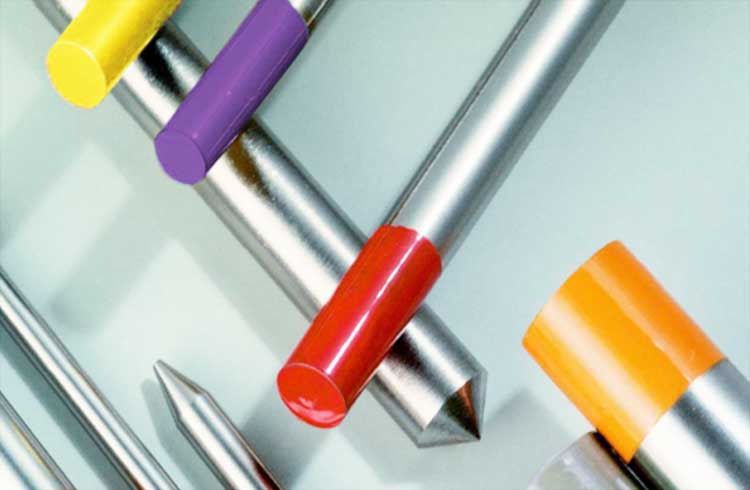How to choose the tungsten electrode
How to choose the tungsten electrode
How Choose the Suitable Tungsten Electrodes

Choosing one of the six commonly available tungsten electrodes is a crucial first step in successful gas tungsten arc welding (GTAW). In addition, tip preparation is critical. The electrode choices are pure tungsten, 2% thoriated, 2% ceriated, lanthanated, zirconiated, and rare earth. The end preparations are balled, pointed, and truncated.
Each electrode is color-coded to eliminate confusion over its type. The color appears at the tip of the electrode.
Lanthanated (Color Code: Black (WL10);Gold(WL15); BLUE ( WL20)
These electrodes have excellent arc starting, a low burn off rate, good arc stability, and excellent reignition characteristics—many of the same advantages as ceriated electrodes. Lanthanated electrodes also share the conductivity characteristics of 2 % thoriated tungsten. In some cases, lanthanated can replace 2% thoriated without having to make significant welding program changes.
Lanthanated tungsten electrodes are ideal if you want to optimize your welding capabilities. They work well on AC or DC electrode negative with a pointed end, or they can be balled for use with AC sine wave power sources. Lanthanated tungsten maintains a sharpened point well, which is an advantage for welding steel and stainless steel on DC or AC from square wave power sources.
Unlike thoriated tungsten, these electrodes are suitable for AC welding and, like ceriated electrodes, allow the arc to be started and maintained at lower voltages. Compared with pure tungsten, the addition of lanthanated increases the maximum current-carrying capacity by approximately 50 percent for a given electrode size.
Composite tungsten (Color Code: TurqoiseWS2 Purple W-E3)
Rare-earth tungsten electrodes (AWS classification EWG,/WS2) contain unspecified additives of rare-earth oxides or hybrid combinations of different oxides, but manufacturers are required to identify each additive and its percentage on the package. Depending on the additives, desired results can include a stable arc in both AC and DC processes, greater longevity than thoriated tungsten, the ability to use a smaller-diameter electrode for the same job, use of a higher current for a similar-sized electrode, and less tungsten spitting
Pure Tungsten (Color Code: Green WP)
Pure tungsten electrodes (AWS classification EWP) contain 99.50% tungsten, have the highest consumption rate of all electrodes, and typically are less expensive than their alloyed counterparts.
These electrodes form a clean, balled tip when heated and provide great arc stability for AC welding with a balanced wave. Pure tungsten also provides good arc stability for AC sine wave welding, especially on aluminum and magnesium. It is not typically used for DC welding because it does not provide the strong arc starts associated with thoriated or ceriated electrodes.
Thoriated (Color Code: Red; WT20)
Thoriated tungsten electrodes (AWS classification EWTh-2) contain a minimum of 97.30% tungsten and 1.70 to 2.20 percent thorium and are called 2%thoriated. They are the most commonly used electrodes today and are preferred for their longevity and ease of use. Thorium increases the electron emission qualities of the electrode, which improves arc starts and allows for a higher current-carrying capacity. This electrode operates far below its melting temperature, which results in a considerably lower rate of consumption and eliminates arc wandering for greater stability. Compared with other electrodes, thoriated electrodes deposit less tungsten into the weld puddle, so they cause less weld contamination.
These electrodes are used mainly for specialty AC welding (such as thin-gauge aluminum and material less than 0.060 inch) and DC welding, either electrode negative or straight polarity, on carbon steel, stainless steel, nickel, and titanium.
During manufacturing, thorium is evenly dispersed throughout the electrode, which helps the tungsten maintain its sharpened edge—the ideal electrode shape for welding thin steel—after grinding. Note: Thorium is radioactive; therefore, you must always follow the manufacturer’s warnings, instructions, and the Material Safety Data Sheet (MSDS) for its use.
Zirconiated (Color Code: Brown(WZr3); White(WZr8))
A zirconiated tungsten electrode produces an extremely stable arc and resists tungsten spitting. It is ideal for AC welding because it retains a balled tip and has a high resistance to contamination. Its current-carrying capability is equal to or greater qthan that of thoriated tungsten. Under no circumstances is zirconiated recommended for DC welding.
Ceriated (Color Code: Grey WCe20)
Ceriated tungsten electrodes (AWS classification EWCe-2) contain a minimum of 97.30 percent tungsten and 1.80 to 2.20 percent cerium and are referred to as 2 percent ceriated. These electrodes perform best in DC welding at low current settings but can be used proficiently in AC processes. With its excellent arc starts at low amperages, ceriated tungsten has become popular in such applications as orbital tube and pipe fabricating, thin sheet metal work, and jobs involving small and delicate parts. Like thorium, it is best used to weld carbon steel, stainless steel, nickel alloys, and titanium, and in some cases it can replace 2 percent thoriated electrodes. Ceriated tungsten has slightly different electrical characteristics than thorium, but most welders can’t tell the difference.
Using ceriated electrodes at higher amperages is not recommended because higher amperages cause the oxides to migrate quickly to the heat at the tip, removing the oxide content and nullifying its process benefits.
